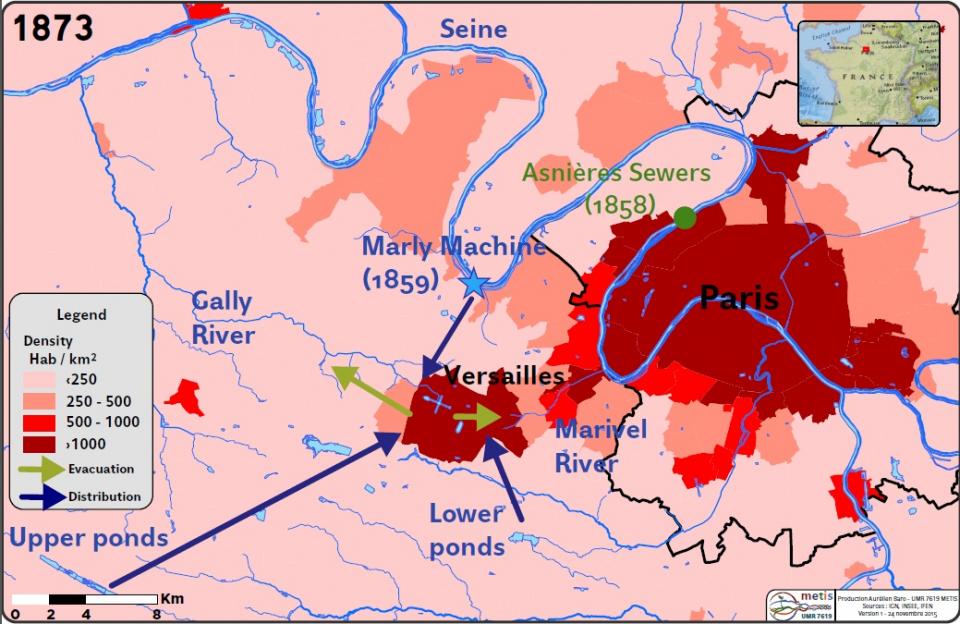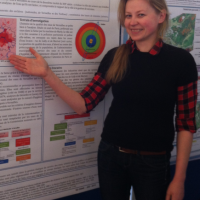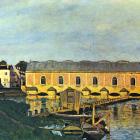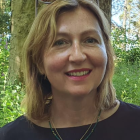In 1859 Versailles and its more than twenty neighboring communities were presented with the new Marly Machine—a hydraulic pump that formed the cornerstone of Versailles’ drinking water supply. This event reinforced the dependence of Versailles on the Seine River and the quality of its water.
In fact, since the foundation of Versailles by King Louis XIV, the city often lacked water. As you can see above, the water first came from local springs, then from a complex system of ponds and finally from the Seine by means of the Marly Machine. The state was the owner of water and water supply infrastructure at Versailles, a unique situation in France. The original 1683 Marly Machine was probably the second most famous pump on the Seine after the Samaritaine in Paris, but it gradually deteriorated due to insufficient maintenance and political aftershocks of the French Revolution. The Samaritaine pump was built about 70 years before the Marly Machine in 1608 to supply water for the Louvre Palace.
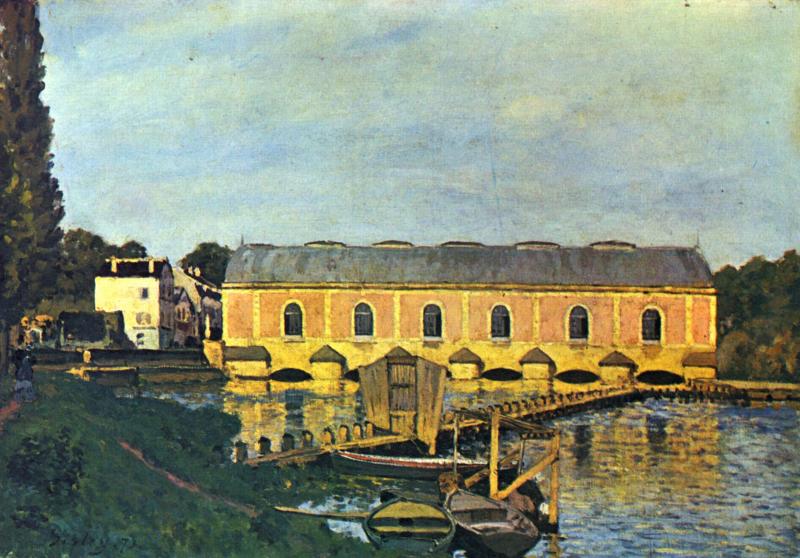
The 1859 Machine de Marly painted by Alfred Sisley in 1873
The 1859 Machine de Marly painted by Alfred Sisley in 1873
Painting by Alfred Sisley in 1873. The title in French: La Machine de Marly.
Current location: Ny Carlsberg Glyptotek. Source/Photographer: The Yorck Project: 10.000 Meisterwerke der Malerei. DVD-ROM, 2002. ISBN 3936122202. Distributed by DIRECTMEDIA Publishing GmbH.
Click here to view Wikimedia source.
 This work is licensed under a Creative Commons Public Domain Mark 1.0 License.
This work is licensed under a Creative Commons Public Domain Mark 1.0 License.
The nineteenth century brought the hygiene revolution and the need for increasing amounts of water for domestic and industrial use. Xavier Dufrayer, engineer of the Arts and Métiers School and future director of Versailles’ water service, was hired to update the Marly Machine. It was financed by Napoleon III’s personal funds. The new Marly Machine, pictured here, was able to pump 20,000 m3 of water per day, enough to secure water supply. But such an expensive re-instalment was soon made problematic because of the growing pollution of the Seine.
Even earlier, in 1858, the section of the Seine just downstream from Paris had become the receptacle of sewage effluents from the French capital. Two big collectors were installed in the city of Asnières to drain Parisian wastewaters (except cesspool discharge) into the Seine; the water was not treated before entering the Seine. For Paris the result was positive; the city became cleaner and its mortality level decreased. However, cities downstream continued to suffer from the Seine’s pollution and, what is more, they installed their own sewage systems, displayed below, that discharged into the river and added to its degradation (Barles 2012, 94–112).
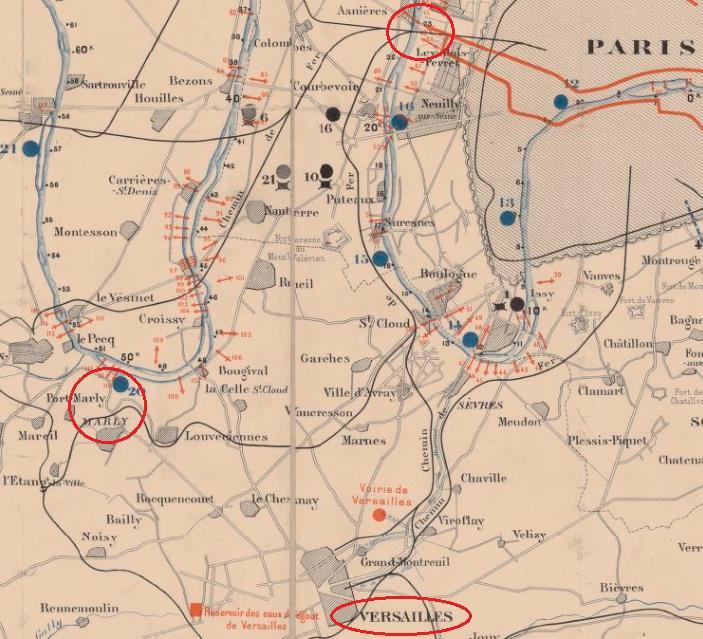
Versailles water intake and Seine River pollution by Paris and suburban cities sewage system. The sewers are marked in orange.
Versailles water intake and Seine River pollution by Paris and suburban cities sewage system. The sewers are marked in orange.
Title: Prises d’eau, égouts et dépotoirs dans les environs de Paris.
Editor: Imp. De Chaix, BnF, GE C-3596.
Click here to view Gallica source.
 This work is licensed under a Creative Commons Public Domain Mark 1.0 License.
This work is licensed under a Creative Commons Public Domain Mark 1.0 License.
The projects of Parisian and regional administrations launched in the 1860s to stop the growing degradation of the Seine didn’t prove to be effective. It appeared that using sewage for agricultural irrigation demanded too much land and chemical treatment with aluminum sulfate was very expensive. In 1874, the pollution of the Seine attained its highest level and newspapers and public complaints spread the news: “if the very fish could complain, they would, as there are many fish on the Seine riverbanks dead from asphyxiation” (Figuier 1873–1877, 144). In the same year, the Seine water was declared undrinkable on the basis of oxygen analyses conducted by Auguste Gérardin, a chemist and inspector of polluting industries and an expert in the sanitation of polluted rivers.
In Versailles, administrations at different levels were overwhelmed with protests about the quality of water being distributed. Some public fountains were equipped with municipal authorities with filters but they were not yet capable of treating wastewater pollution. Following a diarrhea epidemic at the beginning of 1873, the regional hygiene board undertook an ammonia analysis of the water. The considerable increase in ammonia was clear evidence of the degradation of the Seine’s water. The employees of Versailles’ state-owned water service were particularly embarrassed; water they delivered could threaten the public’s health and safety.
Versailles’ water service, managed by the state through the Ministry of Public Works, had never paid particular attention to the quality of the water it delivered. No chemical analyses were made on its behalf until 1873. To prove the quality of the water and to show his personal credibility, water service director Dufrayer argued that he drank the same water and had never had any cause for complaint. However, in 1877, he invited Auguste Gérardin, a famous Parisian chemist, to Versailles. Gérardin declared some pond water safe to drink and the Seine’s water heavily polluted. He also introduced his method of measuring dissolved oxygen to water service employees. From that year on, the water service of Versailles regularly analyzed the water and looked seriously for new sources for drinking water.
In 1879, the Marly-Croissy aquifer was discovered and some of its water was added to the supply system. Furthermore, in 1892, a special commission was established by the Ministry of Public Works under the presidency of the regional governor. Among the main conclusions of the commission was the decision to completely exclude the Seine from the water distribution system and the approval of a budget for the construction of pumps to connect the Marly Machine with underground water. The effective exclusion of the Seine from the supply took place somewhere between September 1893 and the beginning of 1894; no precise date could be found in the records. Following this event, the Marly Machine was kept as a driving force to lift underground water up to distribution reservoirs without any treatment. The Marly Machine was finally decommissioned and demolished in 1963 after almost three centuries of existence.
It took more than thirty years to exclude the polluted Seine water from the water distribution system and replace it with cleaner underground water lifted up by the Marly Machine. The drinking water supply heavily depended on existing infrastructure and could not be easily replaced. Today, the efforts to ensure the purity surface water continue; it is a complex challenge with no simple solution.
How to cite
Dmitrieva, Tatiana. “Versailles’ Drinking Water and the Last Service of the Marly Machine, 1859–1963.” Environment & Society Portal, Arcadia (Autumn 2016), no. 14. Rachel Carson Center for Environment and Society. https://doi.org/10.5282/rcc/7681.
ISSN 2199-3408
Environment & Society Portal, Arcadia
 This work is licensed under a Creative Commons Attribution 4.0 International License.
This work is licensed under a Creative Commons Attribution 4.0 International License.
2016 Tatiana Dmitrieva
This refers only to the text and does not include any image rights.
Please click on an image to view its individual rights status.
- Barles, Sabine. L’invention des déchets urbains—France, 1790–1970. Paris: Champ Vallon, 2005.
- Barles, Sabine, and Lestel, Laurence. “The Nitrogen Question: Urbanization, Indistrialization, and River Quality in Paris, 1830-1939.” Journal of Urban History 33 (2007), 794.
- Barles, Sabine. “Urban Metabolism and River Systems: an historical perspective – Paris and the Seine, 1790–1970.” Hydrology and Earth System Sciences 11 (2007), 1757–1769.
- Barles, Sabine. “The Seine and Parisian Metabolism: Growth of Capital Dependencies in the 19th and 20th Centuries.” In Urban Waters: Rivers, Cities, and the Production of Space in Europe and North America, edited by In S. Castonguay and M. D. Evenden, 94–112. Pittsburgh: Pittsburgh University Press, 2012.
- Gérardin, Gavin, and Emile Remilly. “Mémoires originaux. La qualité des eaux de Versailles en 1879 et 1880.” Revue d’hygiène et de police sanitaire 5 (1883), 265–280.
- Lacour, E., and M. Gavin. “Les eaux de Versailles, leur qualité et leur quantité.” Annales d’hygiène publique et de médecine légale 3 (1896), 255–264.
- Lestel, Laurence. “Experts and Water quality in Paris in 1870.” In Resources of the City. Contributions to an Environmental History of Modern Europe, Historical Urban Studies, edited by Dieter Schott, Bill Luckin, and Geneviève Massard-Guilbaud, 203–214. Aldershot: Ashgate, 2005.
- Log in to post comments
- Print page to PDF


